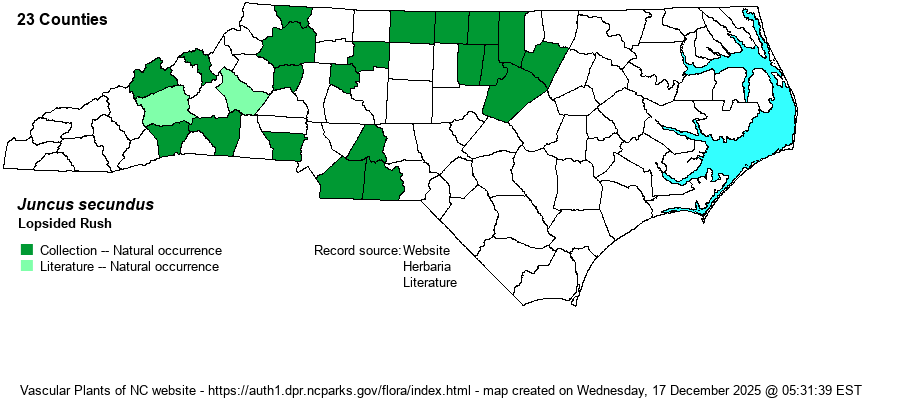| Author | Beauvois ex Poiret | |
| Distribution | Piedmont and low elevations in the Mountains. Some of the gaps in the map will likely be filled with additional collecting. A Moore County specimen (at F) is actually J. dichotomus.
ME to IN, south to northern GA and eastern OK. | |
| Abundance | Uncommon to infrequent in the Piedmont; rare to uncommon in the Mountains, This is a Watch List species. The NCNHP's State Rank of S1S2 is woefully conservative, and the editors suggest a State Rank of S3, or possibly S2S3. | |
| Habitat | Dry rock outcrops, granitic flatrocks, rocky slopes, glades and barrens; sometimes also dry woodlands and openings in thin soil. This is a rare case of non-wetland species of Juncus -- usually in thin soil over a flat rock surface. | |
| Phenology | Flowering and fruiting June-October. | |
| Identification | Lopsided Rush is very similar to the ubiquitous Path Rush (J. tenuis), but the lowest involucral leaf is shorter than the inflorescence and the leaf sheath auricle is very short (vs. prolonged). It is closely related to Georgia Rush (J. georgianus), but Lopsided Rush has shorter tepals (2.5-3.5 mm versus 3.6-5.1 mm in that species) and broader capsules (ellipsoid to globose vs. ellipsoid to narrowly ellipsoid). Both species may have heads arranged along one side of a branch (secund), apparently always in Lopsided Rush. | |
| Taxonomic Comments | None
NOTE on Juncus: These "grasslike" or "sedgelike" plants occur in most habitats, especially where moist or wet. They can immediately be told from grasses and sedges by the presence of 6 tepals (petal-like) that surround the fruit. These tepals can be thought of as analogous to sepals and petals of, say, lilies or trilliums. Most species have brown, chestnut, or reddish tepals and dark brown fruits. The flowers occur in few- to many-flowered heads. Leaves are nearly all basal and round in cross-section. Stems are unbranched, except for the inflorescence. Fruits are termed capsules and contain many tiny seeds. | |
| Other Common Name(s) | Secund Rush | |
| State Rank | S1S2 [S3] | |
| Global Rank | G5? | |
| State Status | W7 [W1] | |
| US Status | | |
| USACE-agcp | FAC link |
| USACE-emp | FACU link |

